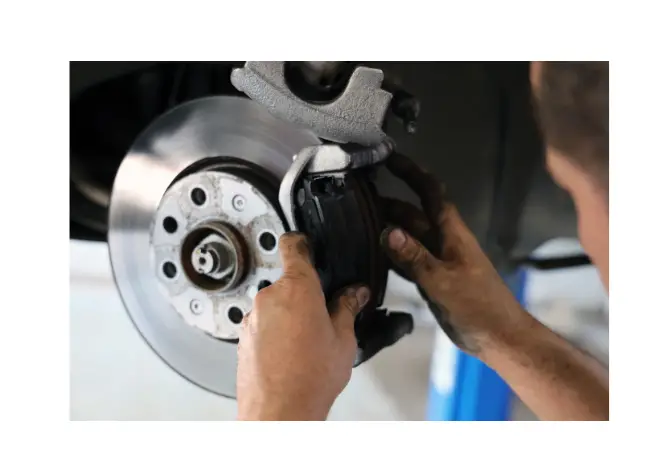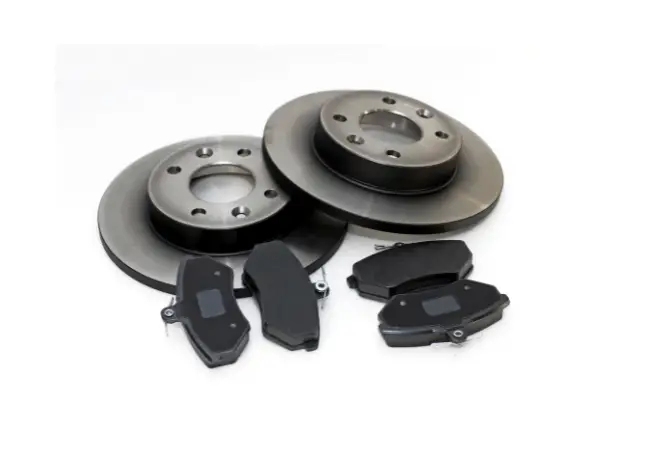Imagine you’re cruising down the highway and suddenly need to make an abrupt stop. You hit the brakes, and the car doesn’t stop as smoothly as it should. That’s when you realize the importance of maintaining your brake rotors. This comprehensive guide on how to clean a brake rotor will cover everything you need to know about cleaning your brake rotors, from understanding their importance to identifying extremely dirty or rusty rotors and even troubleshooting common issues. Get ready to dive into the world of brake rotor maintenance and ensure smooth, safe, and efficient braking for your vehicle.
Contents
- 1 Understanding Brake Rotors and Their Importance
- 2 Identifying Dirty or Rusty Brake Rotors
- 3 Preparing for Brake Rotor Cleaning
- 4 Cleaning Brake Rotors Without Wheel Removal
- 5 Cleaning Brake Rotors by Removing Them from the Vehicle
- 6 Maintaining Brake Rotors and Pads
- 7 Preventing Brake Rotor Corrosion
- 8 Troubleshooting Common Brake Rotor Issues
- 9 Summary
- 10 Frequently Asked Questions
Short Summary
- Maintaining brake rotors is essential for driver safety and performance.
- Cleaning brake rotors requires gathering the necessary supplies, removing them from the vehicle or using an air blower, and lubricating components to prevent corrosion.
- Regular inspections, cleaning, and replacing worn parts are key to preventing common issues with brake rotors.
Understanding Brake Rotors and Their Importance

Brake rotors, also known as brake discs, are crucial components of your vehicle’s brake system. These circular discs work in tandem with brake pads and brake calipers to convert kinetic energy into thermal energy, ultimately slowing down your car when needed. The performance of your braking system is directly impacted by the condition of your brake rotors, making their maintenance a top priority for driver safety.
There are four main types of brake rotors: Blank & Smooth, Drilled, Slotted, and Drilled & Slotted. Each type has its own advantages and can affect brake pad wear differently. Blank and smooth rotors, the most common type found in passenger vehicles, have smooth metal surfaces. Drilled rotors have holes that increase braking power, but they can produce brake dust. Slotted rotors feature long slots that enhance brake output, while drilled and slotted rotors provide exceptional performance due to their combination of drilled holes and slots.
Cleaning brake rotors is essential for reliable, consistent, and powerful braking. Regular cleaning not only improves vehicle performance but also helps maintain the brake linings and other components of the braking system. Additionally, rust on brake rotors can compromise their durability and impact driver safety, making it crucial to clean them regularly to prevent rust buildup.
Identifying Dirty or Rusty Brake Rotors
If your car’s braking performance has diminished, or you hear squeaking noises when applying the brakes, it may be time to inspect your brake rotors for dirt or rust. The steel construction of brake rotors makes them prone to rusting when exposed to moisture, especially when combined with road salt. A visual inspection of the rotor surface can also reveal the presence of rust or brake dust, indicating the need for cleaning.
To ensure optimal braking performance and prevent further issues, it’s essential to address dirty or rusty brake rotors promptly. Regular cleaning can help minimize the accumulation of rust and brake dust, ultimately prolonging the life of your braking system.
Preparing for Brake Rotor Cleaning
Before you begin cleaning your brake rotors, gather the necessary supplies and tools. You’ll need a bucket, cleaning cloths, brake cleaner spray, distilled white vinegar, non-oily rags, steel wool, and protective gloves. A wire brush and an appropriate degreaser are also essential for effectively cleaning your brake rotors. Keep in mind that wearing gloves is important to protect your hands during the cleaning process.
WD-40 Automotive Specialist Brake & Parts Cleaner is a recommended brake cleaner for cleaning brake rotors. Before applying the cleaner, ensure that your oil and brake fluid levels are at appropriate levels. With your supplies and tools ready, you can now proceed to clean your brake rotors using one of two methods: without wheel removal or by removing them from the vehicle.
Cleaning Brake Rotors Without Wheel Removal
Cleaning brake rotors without removing the wheel is a convenient option if you don’t have the time or resources to take the wheel off. To start, spray the brake cleaner on the rotor surface, making sure to reach all areas. Allow the cleaner to rest for a few minutes before rinsing with water. If the rotor is still dirty, you can use a wire brush or steel wool to scrub away any remaining dirt or rust.
If a more cost-effective approach is desired, you can clean the brake rotors using water and soap. After applying the soap solution, it is essential to let the rotor dry. Remove any excess water with a clean, dry rag to prevent rusting. If the soap solution isn’t effective in removing rust, you can switch to using a brake cleaner.
For rust that won’t come off easily, a Daytona brush combined with steel wool or a wire brush will do the trick. These supplies can effectively clean disc brakes and remove surface rust. If the Daytona brush doesn’t provide satisfactory results, you can try using a brake cleaner and a wheel cleaner as an alternative. An air blower can also be employed to blow off brake dust and dirt from the wheel, ensuring the entire rotor is clean.
Cleaning Brake Rotors by Removing Them from the Vehicle
If you have the resources and time, removing the brake rotors from the vehicle allows for a more thorough brake rotor cleaning. This method involves using a brake cleaner spray and a wire brush to eliminate any rust or debris from the rotor after it has been removed from the vehicle.
The Process
Once the brake rotors are removed, you can use white vinegar to clean them if necessary. Soak the new brake rotors in vinegar overnight, and if needed, repeat the process to remove any remaining rust. Remember that this method requires you to remove the brake rotors from the vehicle before cleaning them with white vinegar.
After cleaning the brake rotors, wipe them with a clean cloth and let them air dry. Regular inspection of brake rotors and pads for signs of wear and tear is essential, and worn components should be replaced as needed.
Reinstall the cleaned brake rotors onto your vehicle, and enjoy improved braking performance and safety.
Maintaining Brake Rotors and Pads

Regular maintenance of your brake rotors and pads is crucial for ensuring optimal performance and safety. Conducting routine inspections allows you to assess the condition of your braking system and replace any worn components as necessary.
Cleaning your brake rotors and pads on a regular basis is also vital to prevent the buildup of rust and brake dust. Proper lubrication of brake rotors and pads will further enhance their performance and longevity.
Preventing Brake Rotor Corrosion
To protect your brake rotors from corrosion, consider applying a corrosion inhibitor to the braking surface, outer edge, and center hub of the disc brake rotor. This helps prevent metal-to-metal contact that could lead to equipment malfunction.
In addition to using a corrosion inhibitor, keeping the area around the brake rotors clean and dry is essential to avoid corrosion. Regular cleaning helps to eliminate any dirt or debris that could cause metal-to-metal contact, ensuring your brake rotors remain in optimal condition.
Troubleshooting Common Brake Rotor Issues
Even with proper maintenance, brake rotors can still experience issues such as uneven wear, warping, and persistent rust. Excessive vibration or pulsation, squeaking or squealing noises, and grooves worn into the rotor are common problems that may arise.
To address these issues, ensure that you are regularly cleaning and inspecting your brake rotors and pads for signs of brake pad wear and tear. Replace any worn components as needed and consider using a corrosion inhibitor to protect rotors from rust. By staying proactive and addressing any issues early on, you can maintain the performance and safety of your braking system.
Summary
In conclusion, maintaining clean brake rotors is essential for ensuring smooth, efficient, and safe braking performance. By understanding the importance of brake rotors, identifying dirty or rusty rotors, and following the step-by-step cleaning process, you can keep your braking system in optimal condition. Remember to inspect your brake rotors and pads regularly, maintain a clean and dry environment, and address any common issues that may arise. With proper care and maintenance, you can enjoy a safe and smooth driving experience.
Frequently Asked Questions
Is it OK to spray brake cleaner on rotors?
It is generally safe to spray brake cleaner on rotors, provided it is applied sparingly and with a microfiber cloth for wiping.
However, caution should be exercised when doing so, as brake cleaner can contain dangerous chemicals and is highly flammable. Therefore, it is important to use the product properly and according to the manufacturer’s instructions.
Can I use WD 40 to clean my rotors?
No, WD-40 should not be used to clean brake rotors as it is not designed for this purpose.
Other products are available that are better suited to cleaning brake rotors and will not damage the rotors or other parts of the braking system.
Can I use rubbing alcohol to clean brake rotors?
In conclusion, it is safe to use isopropyl alcohol as a cleaner for brake rotors. However, it is recommended to use a specialist product that does not leave any residue in order to avoid damage to the rotor.
Methylated spirits and isopropyl alcohol are popular options for cleaning disc rotors, without leaving a residue.
How to use brake cleaner?
To use brake cleaner safely and effectively, start by removing all the tires and wheels from the car. Then liberally spray all of the brake parts, including discs or drums, pads, and calipers, and let it sit for a few minutes.
Wipe off the wheel with a lint-free cloth when done, reposition the wheel, and then tighten the lug nuts. Finally, lower the wheel and finish tightening.
When should I inspect and clean my brake rotors?
To ensure safe braking performance and to prevent premature wear, it is important to inspect and clean your brake rotors at least once a year or every 12,000 miles.
